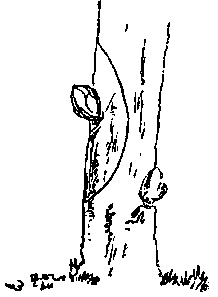Budding
Description
This section is from the book "Trees And Tree-Planting", by James S. Brisbin. Also available from Amazon: Trees and Tree Planting.
Budding
Budding is performed by the transfer of a bud of one tree to the stem or branch of another, generally members of the same genus; though in some species exceptions exist which do not allow of this assimilated connection. The object of budding is to convey the natural qualities of one variety to those of another, either to produce ornamental difference or to multiply productive species, and also to supply deficiencies of limbs in trees naturally of sparse growth. As in layering to produce roots, so in budding, alburnumous substance or sap forms the union between the bud and stock. The operation is usually performed in summer, on the development of the buds of the same season's growth; and as it is required that the bark shall part easily from the wood, both the stock and bud should be of equal advancement in the growth of the season. The sap at this season being in a semi-fluid state, by the action of its natural properties detaches, though little, the bark from the wood, and allows of its being easily raised for the insertion of the portion of bark attached to the bud. The operation of striking out a bud is performed by the insertion of a knife about an inch below the bud, and a cut run to the depth of the bark upward, and curved to about one half inch above it, as shown in the figure on preceding page. This slice, with a thin layer of sap-wood adhering, is then carefully detached from the tree, when the bud will be ready for transfer to the stock. The stock, which should not exceed an inch in diameter, whether as seedling or branch, is previously prepared for the reception of the bud by making a cut downward and across it to the depth of the bark, and of an inch or so in length in the form of a T, as seen in this figure. The portion of the bark containing the bud is then inserted in this T-shaped slit, the edges of which are to be slightly raised to receive it in such a position that the uppermost portion of the bark containing the bud. will fit exactly with the head of the T cut in the stock, so as to admit of the free downward passage of the sap, which forms its annealing substance. The bud, after insertion as above described, is to be bound securely in its place by means of a bandage of woollen yarn, scutched flax, bark bands, or other material. In this state it is allowed to remain for three or four weeks, or until it has united firmly with the stock, when the bandage may be removed. As the season of growth will be nearly over by the time the operation has reached this stage of perfection, the bud need not be expected to push fully into growth till the following spring, though signs of its vitality are often perceptible at an earlier period. Every effort should now be made to nourish its growth, and for this reason all sources of waste of nutritious substances should be cut off, such as suckers or sprouts and any superfluous height of stock.

Another mode, called the, annular budding method, is recommended for its excellence in propagating some forest-trees. It differs from the foregoing by the fitting of the bud to the stock instead of inserting it under the bark; and has the advantage of being successfully performed in the early spring, or as soon as the bark can be detached from the tree. The bud is separated from its tree by a circular cut, extending completely round the stem or branch, and a similar displacement of bark, of the same circuit and height, is made in the stock so as to admit of the bud and its appended parts fitting exactly . into it. This necessitates that the size of the branch from which the bud is taken and that of the stock to which it is to be affixed be equal, or nearly so. A similar treatment is required for this as for the method of inserted buds; but the result of the season's growth will be more apparent in this than in the latter, owing to the advantage derived from the more extended time for its union with the stock.

Continue to:
- prev: Layering
- Table of Contents
- next: Geafting
